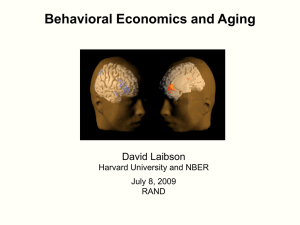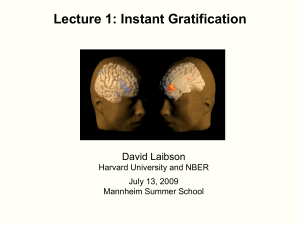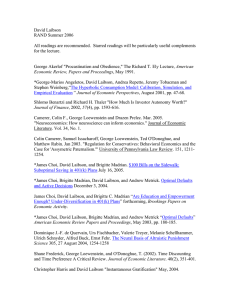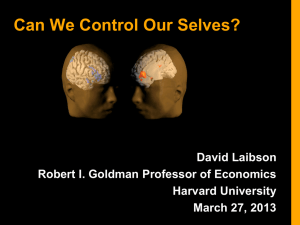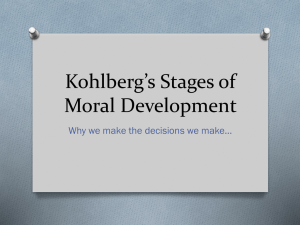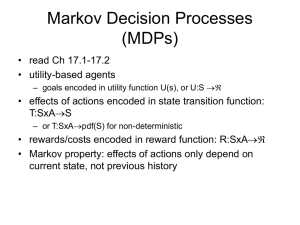PPTX - Harvard University
advertisement
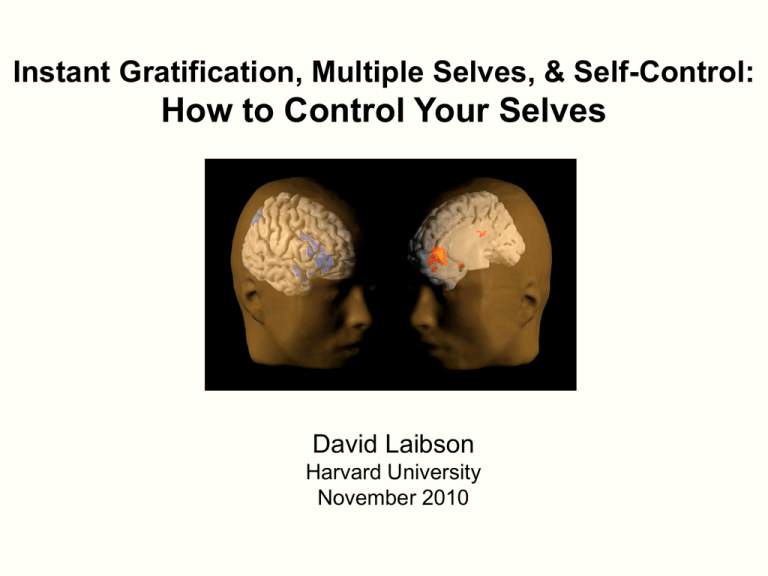
Instant Gratification, Multiple Selves, & Self-Control:
How to Control Your Selves
David Laibson
Harvard University
November 2010
1. Motivating Experiments
A Thought Experiment
Would you like to have
A) 15 minute massage now
or
B) 20 minute massage in an hour
Would you like to have
C) 15 minute massage in a week
or
D) 20 minute massage in a week and an hour
Read and van Leeuwen (1998)
Choosing Today
Eating Next Week
Time
If you were
deciding today,
would you choose
fruit or chocolate
for next week?
Patient choices for the future:
Choosing Today
Eating Next Week
Time
Today, subjects
typically choose
fruit for next week.
74%
choose
fruit
Impatient choices for today:
Choosing and Eating
Simultaneously
Time
If you were
deciding today,
would you choose
fruit or chocolate
for today?
Time Inconsistent Preferences:
Choosing and Eating
Simultaneously
Time
70%
choose
chocolate
Read, Loewenstein & Kalyanaraman (1999)
Choose among 24 movie videos
• Some are “low brow”: Four Weddings and a Funeral
• Some are “high brow”: Schindler’s List
• Picking for tonight: 66% of subjects choose low brow.
• Picking for next Thursday: 37% choose low brow.
• Picking for second Thursday: 29% choose low brow.
Tonight I want to have fun…
next week I want things that are good for me.
Extremely thirsty subjects
McClure, Ericson, Laibson, Loewenstein and Cohen (2007)
• Choosing between,
juice now
or 2x juice in 5 minutes
60% of subjects choose first option.
• Choosing between
juice in 20 minutes or 2x juice in 25 minutes
30% of subjects choose first option.
• We estimate that the 5-minute discount rate is 50% and
the “long-run” discount rate is 0%.
• Ramsey (1930s), Strotz (1950s), Herrnstein (1960s), and
Ainslie (1970s) were the first to understand that discount
rates are higher in the short run than in the long run.
Outline
1.
2.
3.
4.
5.
6.
Motivating experimental evidence
Theoretical framework
Empirical evidence
Neuroscience foundations
Neuroimaging evidence
Policy analysis
2. Theoretical Framework
• Classical functional form: exponential functions.
D(t) = dt
D(t) = 1, d, d2, d3, ...
Ut = ut + d ut+1 + d2 ut+2 + d3 ut+3 + ...
• But exponential function does not show instant
gratification effect.
• Discount function declines at a constant rate.
• Discount function does not decline more quickly in
the short-run than in the long-run.
Discounted value of
delayed reward
Exponential Discount Function
1
Constant rate of decline
0
Now
1
1 11
year
2 years
21
3 years
31
4 years
41
Week (time = t)
-D'(t)/D(t) = rate of decline of a discount function
Exponential
Hyperbolic
5 years
51
Discount Functions
Slow rate of decline
in long run
1
Rapid rate
of decline
in short run
0
Now
1
1 11
year
2 years
21
3 years
31
4 years
41
Week
Exponential
Hyperbolic
5 years
51
An Alternative Functional Form
Quasi-hyperbolic discounting
(Phelps and Pollak 1968, Laibson 1997)
Ut = ut +
dut+1 + d2ut+2 + d3ut+3 + ... Exponential
Ut = ut + b [dut+1 + d2ut+2 + d3ut+3 + ...] Quasi-hyperbolic
b evenly discounts all future periods.
d exponentially discounts all future periods.
For continuous time: see Barro (2001), Luttmer and Marriotti (2003), and
Harris and Laibson (2009)
Building intuition
• To build intuition, assume that b = ½ and d = 1.
• Discounted utility function becomes
Ut = ut + ½ [ut+1 + ut+2 + ut+3 + ...]
• Discounted utility from the perspective of time t+1.
Ut+1 =
ut+1 + ½ [ut+2 + ut+3 + ...]
• Discount function reflects dynamic inconsistency:
preferences held at date t do not agree with preferences
held at date t+1.
Exercise
• Assume that b = ½ and d = 1.
• Suppose exercise (current effort 6) generates delayed
benefits (health improvement 8).
• Will you exercise?
• Exercise Today:
• Exercise Tomorrow:
-6 + ½ [8] = -2
0 + ½ [-6 + 8] = +1
• Agent would like to relax today and exercise tomorrow.
• Agent won’t follow through without commitment.
Self-regulation
• Reduce cost of investment: -6 becomes -1
– walk to work
– stand instead of sitting at a seminar
– conduct walking office hours
• Mix in immediate pleasures: -6 becomes -6+5=-1
– watch low-brow movies on your treadmill
• Commitment: creating “binding” plans
–
–
–
–
–
–
–
make a weight-loss bet with co-workers (cf AA, NA)
remove unhealthy foods from house (icecream, cookies)
get a personal trainer
exercise with friends (see you at 8 AM on the courts)
sign up for a regular exercise class
form study groups (we’ll meet at 10 AM on Saturday morning)
agree to give a paper that you haven’t finished
Commitment is an old idea
Bound to mast
Wax-filled ears
“Ulysses and the Sirens”, Herbert James Draper
Evidence from the field
Choi, Laibson, Madrian, Metrick (2002)
Self-reports about undersaving.
• Survey mailed to employees of US firm
• Matched to administrative data on actual savings behavior
Typical breakdown among 100 employees
Out of
every 100
surveyed
employees
24
68 self-report
saving too little
24 plan to
raise
savings rate
in next 2
months
3 actually follow through over the next four months
Laibson, Repetto, and Tobacman (2010)
Use MSM to estimate discounting parameters:
– Substantial illiquid retirement wealth: W/Y = 3.9.
– Extensive credit card borrowing:
• 68% didn’t pay their credit card in full last month
• Average credit card interest rate is 14%
• Credit card debt averages 13% of annual income
– Consumption-income comovement:
• Marginal Propensity to Consume = 0.23
(i.e. consumption tracks income)
LRT Simulation Model
•
•
•
•
•
•
•
•
Stochastic Income
Lifecycle variation in labor supply (e.g. retirement)
Social Security system
Life-cycle variation in household dependents
Bequests
Illiquid asset
Liquid asset
Credit card debt
• Numerical solution (backwards induction) of 90
period lifecycle problem.
LRT Results:
Ut = ut + b [dut+1 + d2ut+2 + d3ut+3 + ...]
b = 0.70 (s.e. 0.11)
d = 0.96 (s.e. 0.01)
Null hypothesis of b = 1 rejected (t-stat of 3).
Specification test accepted.
Moments:
%Visa:
Visa/Y:
MPC:
f(W/Y):
Empirical
68%
13%
23%
2.6
Simulated (Hyperbolic)
63%
17%
31%
2.7
LRT Intuition
• Long run discount rate is –ln(d) = 4%,
so save in long-run (illiquid) assets.
• Short-run discount rate is –ln(bd) = 40%,
so borrow on your credit card today.
• Indeed, you might even borrow on your
credit card so you can “afford” to save in
your 401(k) account.
Dellavigna and Malmendier (2004, 2006)
•
•
•
•
Average cost of gym membership: $75 per month
Average number of visits: 4
Average cost per vist: $19
Cost of “pay per visit”: $10
Shapiro (2005)
• For food stamp recipients, caloric intake declines by
10-15% over the food stamp month.
• To be resolved with exponential discounting, requires
an annual discount rate of 77%
• Survey evidence reveals rising desperation over the
course of the food stamp month, suggesting that
costless intertemporal substitution is not a likely
explanation
• Households with more short-run impatience
(estimated from hypothetical intertemporal choices)
are more likely to run out of food sometime during the
month.
Willingness to pick up HIV test results: Thornton (2008)
Immediate dollar reward for picking up results
Evidence for Commitment
Ariely and Wertenbroch (2002)
Several proofreading tasks: “Sexual identity is intrinsically
impossible," says Foucault; however, according to de Selby[1], it
is not so much sexual identity that is intrinsically impossible, but
rather the dialectic, and some would say the satsis, of sexual
identity. Thus, D'Erlette[2] holds that we have to choose
between premodern dialectic theory and subcultural feminism
imputing the role of the observor as poet.”
Three arms in study:
• Evenly spaced deadlines ($20)
• Self-imposed deadlines ($13)
– subjects in this condition could self-impose costly
deadlines ($1 penalty for each day of delay) and
37/51 do so.
• End deadline ($5)
Kaur, Kremer, and Mullainathan (2010):
Compare two piece-rate contracts:
Linear piece-rate contract (“Control contract”)
1.
–
2.
Earn w per unit produced
Linear piece-rate contract with penalty if worker does not
achieve production target T (“Commitment contract”)
–
–
–
Earn w/2 for each unit produced if production < T
Jump up at T (jump is T*w/2)
Thereafter, earn w for each unit produced if production ≥ T, earn
Earnings
Never earn more under
commitment contract
May earn much less
T
Production
Kaur, Kremer, and Mullainathan (2009):
• Demand for Commitment (non-paydays)
– Commitment contract (Target>0) chosen 39% of the time
– Workers are 11 percentage points more likely to choose
commitment contract the evening before
• Effect on Production (non-paydays)
– Being offered contract choice increases average
production by 5 percentage points relative to control
– Implies 13 percentage point productivity increase for those
that actually take up commitment contract
– No effects on quality of output (accuracy)
• Payday Effects (behavior on paydays)
– Workers 21 percentage points more likely to choose
commitment (Target>0) morning of payday
– Production is 5 percentage points higher on paydays
Ashraf, Karlan, and Yin (2006)
• Offered a commitment savings product to
randomly chosen clients of a Philippine bank
• 28.4% take-up rate of commitment product
• More hyperbolic subjects were more likely to
take up the product
• After twelve months, average savings
balances increased by 81% for those clients
assigned to the treatment group relative to
those assigned to the control group.
Gine, Karlan, Zinman (2009)
• Tested a voluntary commitment product (CARES) for
smoking cessation.
• Smokers offered a savings account in which they
deposit funds for six months, after which take urine
tests for nicotine and cotinine.
• If they pass, money is returned; otherwise, forfeited
• 11% of smokers offered CARES take it up, and
smokers randomly offered CARES were 3
percentage points more likely to pass the 6-month
test than the control group
• Effect persisted in surprise tests at 12 months.
4. Neuroscience Foundations
•
•
•
•
•
What is the underlying mechanism?
Why are our preferences inconsistent?
Is it adaptive?
How should it be modeled?
Does it arise from a single time preference
mechanism (e.g., Herrnstein’s reward per unit time)?
• Or is it the resulting of multiple systems interacting
(Shefrin and Thaler 1981, Bernheim and Rangel
2004, O’Donoghue and Loewenstein 2004,
Fudenberg and Levine 2004)?
Shiv and Fedorikhin (1999)
• Cognitive burden/load is manipulated by having
subjects keep a 2-digit or 7-digit number in mind as
they walk from one room to another
• On the way, subjects are given a choice between a
piece of cake or a fruit-salad
Processing burden
% choosing cake
Low (remember only 2 digits)
41%
High (remember 7 digits)
63%
Affective vs. Analytic Cognition
Frontal
cortex
mPFC
mOFC
vmPFC
Mesolimbic dopamine
reward system
Parietal
cortex
Relationship to quasi-hyperbolic model
• Hypothesize that the fronto-parietal system is patient
• Hypothesize that mesolimbic system is impatient.
• Then integrated preferences are quasi-hyperbolic
now
t+1
t+2
t+3
PFC
1
1
1
1
…
Mesolimbic
1
0
0
0
…
Total
2
1
1
1
…
Total normed
1
1/2
1/2
1/2
…
Relationship to quasi-hyperbolic model
• Hypothesize that the fronto-parietal system is patient
• Hypothesize that mesolimbic system is impatient.
• Then integrated preferences are quasi-hyperbolic
Ut =
ut + b [dut+1 + d2ut+2 + d3ut+3 + ...]
(1/b)Ut =
(1/b)ut + dut+1 + d2ut+2 + d3ut+3 + ...
(1/b)Ut =(1/b-1)ut + [d0ut + d1ut+1 + d2ut+2 + d3ut+3 + ...]
limbic
fronto-parietal cortex
Hypothesis:
Limbic system discounts reward at a higher rate than does the
prefrontal cortex.
1.0
discount value
mesolimbic system
prefrontal cortex
0.0
time
5. Neuroimaging Evidence
McClure, Laibson, Loewenstein, and Cohen (2004)
• Do agents think differently about immediate rewards and
delayed rewards?
• Does immediacy have a special emotional drive/reward
component?
• Does emotional (mesolimbic) brain discount delayed
rewards more rapidly than the analytic (fronto-parietal
cortex) brain?
Choices involving Amazon gift certificates:
Time
delay
Reward
d>0
d’
R
R’
Hypothesis: fronto-parietal cortex.
Time
delay
d=0
d’
Reward R
R’
Hypothesis: fronto-parietal cortex and limbic.
McClure, Laibson, Loewenstein, and Cohen (2004)
Emotional system responds only to immediate rewards
7
T13
0
Neural activity
x = -4mm
VStr
y = 8mm
MOFC
z = -4mm
MPFC
PCC
Seconds
Earliest reward available today
Earliest reward available in 2 weeks
Earliest reward available in 1 month
0.4%
2s
Analytic brain responds equally to all rewards
VCtx
PMA
RPar
DLPFC
VLPFC
LOFC
x = 44mm
0.4%
2s
x = 0mm
0
T13
15
Earliest reward available today
Earliest reward available in 2 weeks
Earliest reward available in 1 month
Brain Activity
Brain Activity in the Frontal System and
Emotional System Predict Behavior
(Data for choices with an immediate option.)
0.05
0.0
-0.05
Choose
Smaller
Immediate
Reward
Frontal
system
Emotional
System
Choose
Larger
Delayed
Reward
Open questions
1. What is now and what is later?
• Our “immediate” option (Amazon gift certificate)
did not generate immediate “consumption.”
• Also, we did not control the time of consumption.
2. How does the limbic signal decay as rewards are delayed?
3. Would our results replicate with a different reward domain?
4. Would our results replicate over a different time horizon?
Experiment on primary rewards: Juice
McClure, Ericson, Laibson, Loewenstein, Cohen
(Journal of Neuroscience, 2007)
Subjects water deprived for 3hr prior to experiment
From:
Subject: I hate you
To: dardenne@Princeton.edu
Cc: smmcculre@Princeton.edu
I’m already thirsty! It’s 4:00!
(subject scheduled for 6:00)
A
15s
i
ii
10s
5s
Time
…
iii
iv. Juice/Water squirt (1s
)
B
(i) Decision Period
Free (10s max.)
(ii) Choice Made
2s
15s
Figure 1
(iii) Pause
Variable Duration
(iv) Reward Delivery
Free (1.5s Max)
Experiment Design
d
d'-d
(R,R')
{ This minute, 10 minutes, 20 minutes }
{ 1 minute, 5 minutes }
{(1ml, 2ml), (1ml, 3ml), (2ml, 3ml)}
d = This minute
d'-d = 5 minutes
(R,R') = (2ml, 3ml)
Comparison with Amazon experiment:
Impatient areas (p<0.001)
x = 0mm
y = 8mm
Patient areas (p<0.001)
x = 0mm
x = -48mm
Juice
only
Figure 5
Impatient areas (p<0.01)
x = -4mm
y = 12mm
Patient areas (p<0.01)
x = 0mm
Amazon
only
x = -48mm
Both
Measuring discount functions using
neuroimaging data
• Impatient voxels are in the emotional (mesolimbic)
reward system
• Patient voxels are in the analytic (prefrontal and
parietal) cortex
• Average (exponential) discount rate in the impatient
regions is 4% per minute.
• Average (exponential) discount rate in the patient
regions is 1% per minute.
Hare, Camerer, and Rangel (2009)
Health Session
4s
food item
presentation
Taste Session
Rate Health
+
Decision Session
Rate Taste
Decide
+
+
?-?s
fixation
Rate Health
Rate Taste
Decide
Rating Details
• Taste and health ratings made on five
point scale:
-2,-1,0,1,2
• Decisions also reported on a five point
scale: SN,N,0,Y,SY
“strong no” to “strong yes”
What is self-control?
• Rejecting a good tasting food that is not healthy
• Accepting a bad tasting food that is healthy
More activity in DLPFC in trials with
successful self control than in trials with
unsuccessful self-control
L
p < .001
p < .005
Figner, Knoch, Johnson, Krosch, Lisanby,
Fehr and Weber (2010)
• Disruption of left lateral prefrontal cortex (LPFC) with
repetitive transcranial magnetic stimulation (rTMS)
increases choice of immediate rewards over larger
delayed rewards.
• rTMS did not change choices involving only delayed
rewards or valuation judgments of immediate and
delayed rewards.
• Causal evidence for a neural lateral-prefrontal
cortex–based self-control mechanism in intertemporal
choice.
Albrecht, Volz, Sutter, Laibson, and von Cramon (2010)
• An immediate reward in a choice set elevates activation
of the ventral striatum, pregenual anterior cingulate
cortex and anterior medial prefrontal cortex.
• These dopaminergic reward areas are also responsive
to the identity of the recipient of the reward.
• Even an immediate reward does not activate these
dopaminergic regions when the decision is being
made for another person.
• Results imply that participants show less affective
engagement (i) when they are making choices for
themselves that only involve options in the future or (ii)
when they are making choices for someone else.
• Also find that behavioral choices reflect more
patience when choosing for someone else.
Summary of neuroimaging evidence
• One system associated with midbrain dopamine
neurons (mesolimbic dopamine system) discounts at
a high rate.
• Second system associated with lateral prefrontal and
posterior parietal cortex responsible for selfregulation (shows relatively little discounting)
• Combined function of these two systems accounts for
decision making across choice domains, including
non-exponential discounting regularities.
Outline
1.
2.
3.
4.
Experimental evidence for dynamic inconsistency.
Theoretical framework: quasi-hyperbolic discounting.
Field evidence: dynamic decisions.
Neuroscience:
– Mesolimbic Dopamine System (emotional, impatient)
– Fronto-Parietal Cortex (analytic, patient)
5. Neuroimaging evidence
– Study 1: Amazon gift certificates
– Study 2: juice squirts
– Study 3: choice of snack foods
– Study 4: rTMS
– Study 5: intertemporal choices for others
6. Policy
Opt-in 401(k) enrollment
Opt-out enrollment (auto-enrollment)
PROCRASTINATION
UNDESIRED
BEHAVIOR:
Non-participation
START HERE
DESIRED
BEHAVIOR:
participation
Madrian and Shea (2001)
Choi, Laibson, Madrian, Metrick (2004)
401(k) participation by tenure at firm
100%
Opt-out
enrollment
80%
60%
Opt-in
enrollment
40%
20%
0%
0
6
12
18
24
30
36
Tenure at company (months)
42
48
Do people like a little paternalism?
Survey given to workers who were subject to automatic
enrollment:
“You are glad your company offers automatic
enrollment.”
Agree? Disagree?
• Enrolled employees:
• Non-enrolled employees:
• All employees:
98% agree
79% agree
97% agree
Source: Harris Interactive Inc.
Active Choice
PROCRASTINATION
UNDESIRED
BEHAVIOR:
Must choose for oneself
Non-participation
START HERE
DESIRED
BEHAVIOR:
participation
401(k) participation by tenure
Fraction of employees ever
participated
100%
Active Choice Cohort
80%
60%
Opt-in cohort
40%
20%
0%
0
6
12 18 24 30 36 42
Tenure at company (months)
48
54
Active decision cohortCarroll,
Standard
enrollment
cohort Metrick (2009)
Choi, Laibson,
Madrian,
Quick enrollment
PROCRASTINATION
UNDESIRED
BEHAVIOR:
Non-participation
START HERE
DESIRED
BEHAVIOR:
participation
Quick enrollment
PROCRASTINATION
UNDESIRED
BEHAVIOR:
Non-participation
START HERE
DESIRED
BEHAVIOR:
participation
Simplified enrollment raises participation
Fraction Ever Participating in
Plan
Beshears, Choi, Laibson, Madrian (2008)
50%
2005
2004
40%
30%
2003
20%
10%
0%
0
3
6
9 12 15 18 21 24 27 30 33
Time since baseline (months)
The science of self-regulation
• Can we design new methods for self-regulation?
• Can we improve the menu of options for commitment?
What kind of commitment do people want?
Beshears, Choi, Laibson, Madrian, Sakong (2010)
• Give subjects a budget ($50, $100, or $500)
and ask them to allocate between:
– Freedom account (22% interest)
– Commitment account (22% interest): restrictions
on withdrawal before self-selected goal date,
about 100 days in the future
• Economically speaking, the Freedom account
dominates the Commitment account (Freedom
account has greater liquidity)
Proportion invested in commitment account
Beshears, Choi, Laibson, Madrian, Sakong (2010)
Outline
1.
2.
3.
4.
5.
6.
Motivating experimental evidence
Theoretical framework
Field evidence
Neuroscience foundations
Neuroimaging evidence
Policy discussion
• Defaults
• Deadlines
• Simplicity
• New tools for self-regulation and commitment
A copy of these slides is available on my website.

